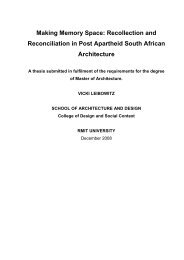Objects in Flux - RMIT Research Repository - RMIT University
Objects in Flux - RMIT Research Repository - RMIT University
Objects in Flux - RMIT Research Repository - RMIT University
Create successful ePaper yourself
Turn your PDF publications into a flip-book with our unique Google optimized e-Paper software.
<strong>Objects</strong> <strong>in</strong> <strong>Flux</strong><br />
pr<strong>in</strong>ciples. From personal experience, task-ori-<br />
ented learn<strong>in</strong>g tended to produce a patchwork<br />
collection of knowledge that did not always<br />
give a clear overview of the field <strong>in</strong> which I was<br />
operat<strong>in</strong>g. xxiii<br />
The eclectic scope and task-oriented nature of<br />
these practices often meant that knowledge I<br />
accessed, developed or deployed for a specific<br />
project was not readily reta<strong>in</strong>ed <strong>in</strong> my memory.<br />
Document<strong>in</strong>g projects for public presentation<br />
provided an opportunity to reflect on this knowl-<br />
edge. While prepar<strong>in</strong>g project documentation I<br />
often found additional research was required to<br />
br<strong>in</strong>g a suitable level of clarity to the presenta-<br />
tion. Although this documentation was generally<br />
produced for public consumption, it also served<br />
as a useful reference for my own practice and<br />
on a number of occasions I returned to my own<br />
project documentation for guidance when devel-<br />
op<strong>in</strong>g new works. xxiv<br />
5.5 Embodied knowledge<br />
Aside from the disembodied knowledge dis-<br />
cussed above, a second form of knowledge is<br />
discernible with<strong>in</strong> practices of object modifica-<br />
tion – an embodied knowledge that is locally<br />
constituted and <strong>in</strong>timately bound to the practi-<br />
tioner and the place of action. This knowledge is<br />
equivalent to a way of work<strong>in</strong>g, act<strong>in</strong>g or be<strong>in</strong>g.<br />
It is, <strong>in</strong> its extremes, both de Certeau’s ‘ways of<br />
xxiii. See the blog post The Unknown Unknown<br />
for a discussion of the difficulty <strong>in</strong> see<strong>in</strong>g the<br />
gaps <strong>in</strong> your own knowledge, http://www.<br />
openobject.org/objects<strong>in</strong>flux/?p=14 accessed<br />
16 January 2011.<br />
xxiv. The use of one’s own documentation as a<br />
reference guide is also noted <strong>in</strong> Torrey et al.’s<br />
study of How-tos (2007).<br />
96<br />
Woz is God, or possibly the antichrist.<br />
Published Thursday, July 20, 2006<br />
http://www.openobject.org/objects<strong>in</strong>flux/?p=8<br />
As I was contemplat<strong>in</strong>g a title for this post I realised that<br />
‘woz’ is ‘god’ backwards, or at least it’s ‘god’ transposed<br />
onto a backwards alphabet. Check it out:<br />
a b c d e f g h i j k l m n o p q r s t u v w x y z<br />
z y x w v u t s r q p o n m l k j i h g f e d c b a<br />
| | |<br />
Take the letter “o” as the rotation po<strong>in</strong>t, flip the alphabet<br />
backwards and then transpose the word ‘god’ onto the reversed<br />
alphabet. You get ‘woz’.<br />
I’m talk<strong>in</strong>g about Steve Wozniak (co-founder of Apple<br />
Computer; you can read about Woz at Wikipedia1 ) and<br />
although he may not be an actual god (or even the antichrist;<br />
notwithstand<strong>in</strong>g that whole $666.66 pric<strong>in</strong>g issue... 2 ) he is<br />
quite amaz<strong>in</strong>g. In ’86 a friend of m<strong>in</strong>e at Yarrawonga High<br />
got a ‘limited edition’ Apple IIgs signed by Woz (Apple<br />
made at least 10,000 of these ‘limited editions’). I remember<br />
th<strong>in</strong>k<strong>in</strong>g, ‘you’d have to be pretty special to get your name<br />
on a computer.’ Woz is pretty special (and probably a bit of<br />
a dork, but hey, <strong>in</strong> the 80’s be<strong>in</strong>g a dork could be truly cool,<br />
not just faux-cool like it is now).<br />
The reason I mention Woz is that I’ve just been mess<strong>in</strong>g<br />
around with the Apple Desktop Bus3 , a system Apple used<br />
to connect keyboards and mice to their computers. Woz<br />
developed the ADB <strong>in</strong> the mid ’80’s (it was later replaced by<br />
the <strong>in</strong>dustry standard USB, however, due to its simplicity it<br />
was still be<strong>in</strong>g used <strong>in</strong>ternally on Apple laptops as recently<br />
as 2005). ADB’s simplicity epitomises Woz’s approach<br />
1/ http://en.wikipedia.org/wiki/Woz, accessed July 20, 2006.<br />
2/ See the orig<strong>in</strong>al Apple I pr<strong>in</strong>t ad, www.apple-history.com<br />
/images/apple1.gif accessed 20 July 2006.<br />
3/ http://en.wikipedia.org/wiki/Apple_Desktop_Bus accessed<br />
20 July 2006.
















